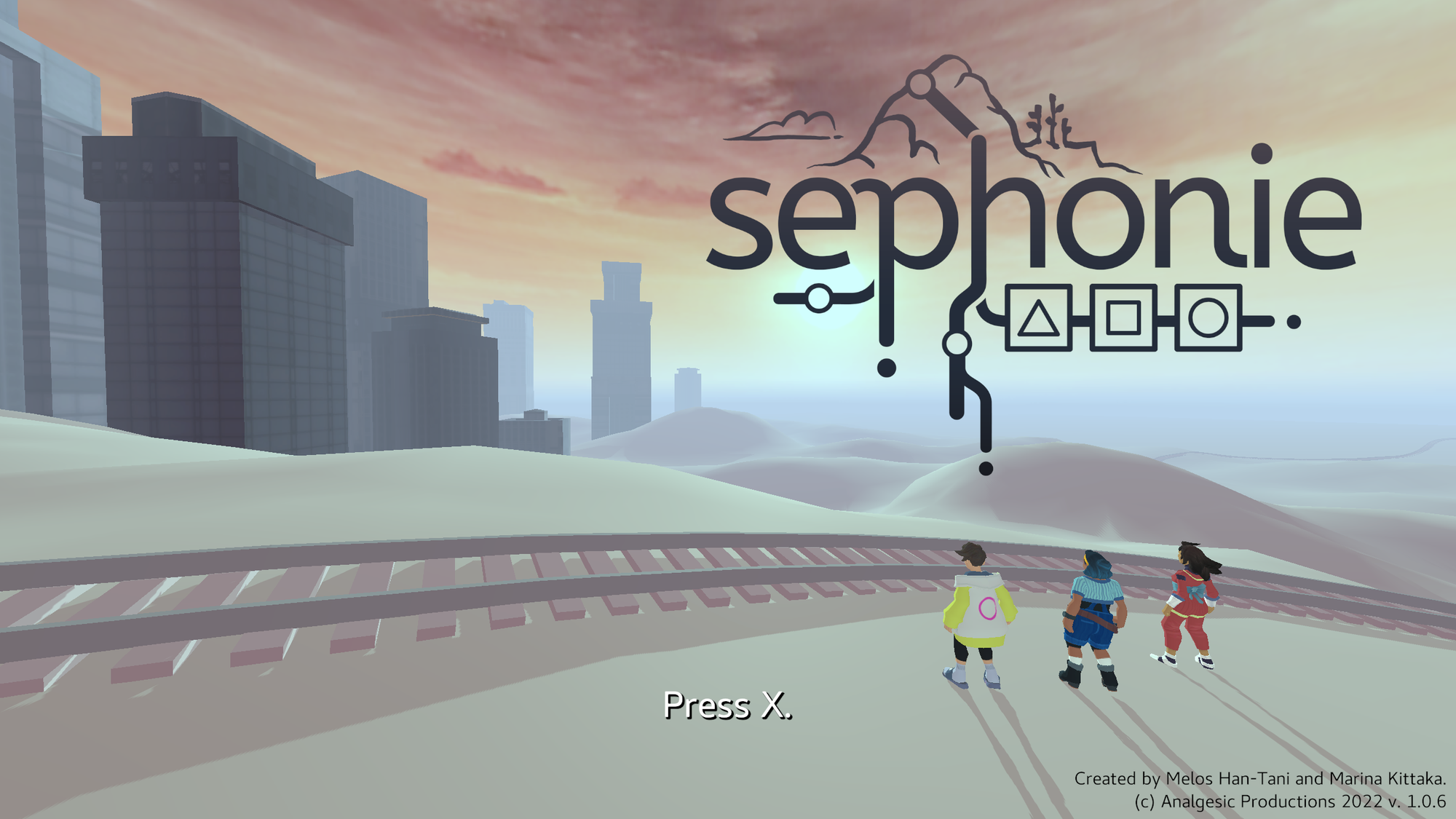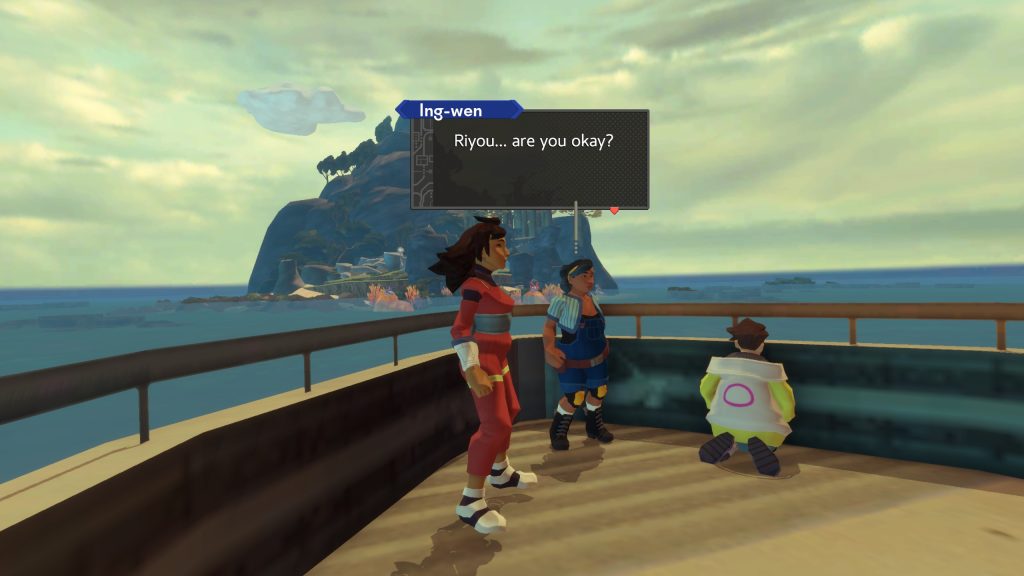
Sephonie is a narrative-heavy mashup of puzzles and platforming created by Melos Han-Tani and Marina Kitakka, the developer duo behind the beloved Anodyne games (as well as numerous other small works in various media). Their work has a reputation for being avant-garde and sometimes metatextual, consisting of expressionistic art and writing with a distinctive voice.
Sephonie tells the story of three scientists from the U.S., Taiwan, and Japan on an expedition to conduct research on a previously unexplored island off the coast of Taiwan. Visually, Sephonie follows on the heels of Anodyne 2’s low-poly 3D art style, reminiscent of PlayStation-era graphics. The music oscillates between chipper and melancholic, almost nostalgic somehow. Sephonie’s moment-to-moment play involves jumping, wall-running, and playing through mellow Tetris-like puzzle segments. But amidst these aesthetic trappings sits a unique story about heritage, privilege, ecology, and human connection, as grand and sweeping as it is quiet and personal.
Like Riding a… Skateboard?
One of the most immediately notable things about Sephonie would be its exceedingly odd platforming mechanics. Early on, the game implores players to stick with its default gameplay options and learn to control the sprinting, wall-running and dashing mechanics as they’re presented. But it also admits that the way that it implements these verbs is atypical and may require some adjustment, likening the sprinting movement to “riding a skateboard” more than running around in a typical 3D platformer.
At first, it didn’t click for me at all. It’s as weird to control as the game itself admits, and it undoubtedly requires patience and practice. But I trusted the developers to deliver something intentional, and after some time with it I started to get the hang of the movement. Wall-running turned out to be a bit finicky all the way through, but by the end of the game, I not only understood how to control the characters well, but agreed with the developers’ implication: that the movement mechanics were well-suited to the game that they made.

For players to follow along when they’re initially thrown off balance is a significant ask, but it’s one that feels reasonable in the context of niche games from very small studios. People building games in small teams often need to push boundaries to stand out and build something unique. I can’t help but wonder if there could have been ways to better tutorialize that didn’t resort to pleading the player to stick with it, but it ultimately was enough when taken in good faith.
While exploring Sephonie, the scientists encounter new species of flora and fauna to analyze, triggering puzzle sequences that involve placing multicolored Tetris-like blocks. The goal is to form large regions of matching colors to rack up points and progress the encounter, taking care to score a minimum number of points during each round. It’s relaxing and not especially difficult, but it provides a nice break from platforming in the same way other 3D platformers might employ combat encounters or minigames. By and large, I found myself wishing they were more challenging, but they nonetheless worked as a pacing mechanism and source of variety.
All told, Sephonie’s mechanical conceits are charmingly unusual and mostly inoffensive; some even grew on me quite a bit as the game progressed. To me, this experience demonstrates the importance of taking indie works at face value as much as possible. And to their credit, Sephonie’s developers still provide settings to tweak difficulty and simplify the trickiest parts of the platforming, which was comforting to have available as an option.
Hearts and Minds
The story of Sephonie is hard to succinctly describe; it examines its many themes through a number of different parallel lenses. The direct plot setup is simple: three researchers find themselves marooned on a research expedition to an unexplored island, equipped with high-tech gear that lets them neurologically interface with the unique flora and fauna on the island and catalog ecological data (in addition to giving them super-human parkour abilities, it would seem).

Over the course of their exploration, the island itself morphs into increasingly surreal spaces that represent the characters own memories, anxieties, and hopes. The three protagonists hail from different nations but are all of Taiwanese descent to some degree, and their varying connections to this heritage is a consistent throughline. As the three explore the island and come to understand its intricate ecology, it becomes clear that the island itself is a living entity capable of communicating with them. Major checkpoints in the game’s story are paired with “mindshare” sequences, in which the island explores the researchers’ lives and histories through the neurological linking technology they’ve brought with them. These sequences are also implied to be connecting the scientists to one another, expanding their mutual understanding and helping them grow as individuals and as a team.
The mindshare sequences are beautiful dioramas that showcase the expressiveness and distinct video-game aesthetic of the art style, overlaid with poignant prose that examines the histories of the trio through little bits of daily minutia and recalled memories.
Sephonie’s storytelling blends a lot of thematic elements, but feels like it’s fundamentally an extended meditation on personal history and the experiences of being mixed-race, being children of immigrants, and working under large institutions. The wistfulness and beauty of the story sequences are what won me over on the game as a whole and pulled it into my top 10 list.
The World Changes
There’s one last detail that’s worth noting about Sephonie’s storytelling: it’s a game that began its development in mid-2019 and released after multiple years of development during the global COVID-19 pandemic. The credits openly acknowledge that this fact profoundly influenced the story.
I don’t want to say too much about this, but the way the game’s story develops is evidently tinged with the uncertainty, bitterness, and hope for a brighter tomorrow that characterized the lockdowns early in the pandemic. It’s interesting to imagine what the game might have been without these dramatic changes to daily life.

The influence of these events is undeniable in plenty of recently-released art, but there’s something compelling about the way that Sephonie explores these collective traumas that’s hard to put my finger on. Suffice it to say that the game takes some intriguing swerves in its final moments (be sure to watch the epilogue once you beat it).
Conclusion
I don’t have a lot of well-structured thoughts about Sephonie, and I don’t think there’s space on a Game of the Year post to do any deep analytical work (which would require substantial spoilers). It’s a game that communicates a lot of different ideas and doesn’t do a whole lot to tie them all together thematically, but it left me with an unshakeable feeling those connections will manifest as I mull it over.
It’s possible that I’m mistaken, and that the storytelling is just a little all-over-the-place. Maybe the coherent connective throughline I’m looking for isn’t quite there. But that would be okay too, because Sephonie is still content to be expressionistic, and it conveys itself very capably in that mode. If Anodyne 2 spoke to you at all or you like surreal storytelling and low-poly art styles, Sephonie is worth your time; and a little bit of patience, too, if needed.